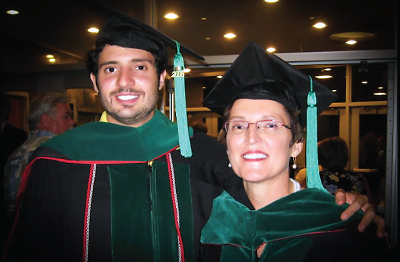Film to Explore Factors Contributing to Physician Suicide
Abstract
According to the American Foundation for Suicide Prevention, 350 to 400 physicians in the United States die by suicide annually.
“My family, I love you. To others who have been good friends, I love you too. This is just the end of the line for my particular train,” Greg Miday, M.D., a physician working at Barnes-Jewish Hospital at Washington University, wrote in a note before taking his life on June 22, 2012.

Greg Miday, M.D., lost his life to suicide at the age of 29, one week before he was due to enter an oncology fellowship. He is photographed with his mother, psychiatrist Karen Miday, M.D., at his medical school graduation.
Miday’s story is one of several featured in the film “Do No Harm,” which explores the factors contributing to physicians’ having the highest rate of suicide among any profession. Filmmaker Robyn Symon said she expects the film to be completed in 2017 and released in 2018.
According to the American Foundation for Suicide Prevention, 350 to 400 physicians in the United States die by suicide annually. Women physicians are 2.3 times more likely to die by suicide than those in the general population; male physicians, 1.4 times more likely. Symon said she was alarmed by the high suicide rate among physicians and saw the film as an opportunity to raise awareness about the extent of the problem.
“I’m hoping to expose this problem and create a national and international dialogue about the crisis of physician suicide and how it impacts patients,” Symon told Psychiatric News. In addition to making documentary films, Symon is a two-time Emmy-winning producer and director who has produced programming for many national networks.
Why Do Clinicians Have High Rates of Suicide?
In a column published last year in Psychiatric News, APA President Maria A. Oquendo, M.D., Ph.D., wrote of the mental health challenges that trainees and physicians face and the factors that may contribute to their hesitancy to seek mental health care (Psychiatric News, September 16, 2016).
Town Hall to Be Held on Physician Burnout
Physician burnout will be addressed at APA’s 2017 Annual Meeting in the session “Physician Wellness and Burnout: A Town Hall Discussion With APA Leadership.” Participating are APA President-elect Anita Everett, M.D., who will chair the session, and APA CEO and Medical Director Saul Levin, M.D., M.P.A., and Trustee-at-Large Richard Summers, M.D. Join in the discussion on Sunday, May 21, at 10 a.m. in Room 30B of the San Diego Convention Center.
“[S]tigma is alive and well among physicians,” Oquendo wrote, noting concerns by some that seeking mental health care will have a negative impact on career prospects.
“A critical question is why no one detects the suffering of these physicians. After all, they are surrounded by other health care professionals who should be able to see what is happening,” she continued. “However, most physicians have enormous personal strength, both emotional and intellectual ‘reserves.’ Accordingly, they often are able to compensate for the presence of psychiatric symptoms, which both makes it difficult to identify them so they can receive assistance and leads them to feel more isolated, since no one knows how they really feel.”
Symon added that the culture of medicine, beginning in medical school, likely deters clinicians from seeking care (see box). “Physicians are perceived to be superhuman—any sign of weakness is frowned upon,” she said.
If physicians are to stop or reduce the number of suicides among their colleagues, they must “stop blaming and shaming the victims,” Pamela Wible, M.D., a family physician who started a suicide hotline for physicians several years ago, told Psychiatric News.
Psychiatry Crucial to Destigmatization
Psychiatrist Karen Miday, M.D., the mother of Greg Miday, said she believes psychiatrists should do more to raise awareness about suicide among physicians.
Miday, who is also featured in “Do No Harm,” said that Greg had struggled with depression and anxiety and drank to excess at times to deal with symptoms of anxiety. As a perfectionist, he excelled in his medical school classes at Ohio State University and felt great shame when he was referred to a physician’s health program (PHP) due to his drinking problem. According to Miday, the program remanded her son to a 12-step rehab program. He was under the care of that PHP when he died. His suicide was precipitated by a relapse in his drinking and a breakup of a relationship, his mother said.
“Organized psychiatry has the power to reduce the stigma surrounding mental illness in physicians,” she told Psychiatric News. “We say that 1 out of every 5 people has a mental illness, but we don’t really like to acknowledge that means that 1 out of every 5 doctors has a mental illness,” she added.
According to psychiatrist Darryl Kirch, M.D., who is president and CEO of the Association of American Medical Colleges (AAMC) and was interviewed as part of Symon’s film, “the only specialty that is perfectly equipped to assert leadership around the problem of physician burnout, depression, and suicide is psychiatry.”
At APA’s Annual Meeting in San Diego, APA President-elect Anita Everett, M.D., will chair a town hall discussion on the drivers of physician burnout and strategies for promoting wellness (see box).
Other professional medical organizations are also working to address the challenge of physician burnout. For instance, AAMC, which works with all the medical schools and teaching hospitals in the United States, recently launched a website to model best practices to promote well-being among medical students. At a number of medical schools, Kirch noted, there have been efforts not just to prevent suicide among medical students, but also to address the precursors of depression and burnout with practices such as mindfulness and meditation.
In addition, the AMA offers online modules as part of its StepsForward program for physicians and residents geared toward preventing distress and suicide and promoting well-being. ■



